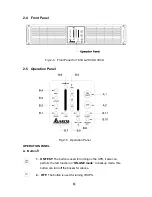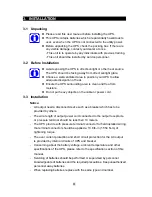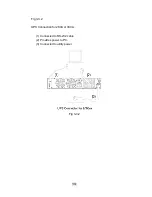
2 0
7. TROUBLESHOOTING
Problem Possible
Cause
Solution
ON/TEST button is not pushed.
Press the “ON TEST” button to turn on the
UPS.
(Refer section 4 to turn on the UPS.)
Battery low shut down and
utility is absent.
Waiting for line recovery.
The rear panel input circuit
breaker is tripped. (Button is
tripped out)
1. Reduce some loads connected to the UPS.
2. Reset the circuit breaker. (Push
button in)
UPS is not turned
on.
(No alarm, No LED
lights)
UPS fault.
Call for qualified service personnel if above
actions do not solve the problem.
Batteries inside the UPS are
not fully charged.
Recharge the batteries for at least 8 hours.
UPS is overloaded.
Remove some unnecessary loads.
Batteries are weak.
Batteries weak faster when used often or
operating at higher temperature.
If the battery is near the end of its life, call for
service personnel. Replace the battery even if
the REPLACE BATTERY LED does not light.
UPS does not
provide expected
back-up time.
Charger fault or other reason. Call for service.
All LEDs light on.
Internal UPS fault.
1. Turn off UPS.
2. Call for service.
“REPLACE
BATTERY” LED
lights on.
Weak batteries.
1. Recharge the batteries for at least 8
hours.
2. If problem remains Call for service
personnel to, replace the batteries.
Incorrect transmission speed.
Re-test after using another different
transmission speed.
PC-UPS
communication does
not work properly.
Incorrect RS-232 connection.
Refer to communication interface (Section 8) of
this manual Re-connect the UPS with COM1 /
COM2 on PC again.
No incoming utility.
Check input power connection.
The rear panel input circuit
breaker is tripped. (Button is
out).
1. Reduce some loads connected to the UPS.
2. Reset the circuit breaker. (Push button in)
UPS operates on
battery even though
the line is in normal
operating condition.
Very high, low or distorted
utility voltage.
Have qualified electrician check the input
voltage.
Site wiring fault LED
(fault led flash).
Wiring error such as reversed
hot/neutral.
Get wiring checked by electrician.
The exhaust fans and ventilation
grills may be obstructed.
Choose a well-ventilated area to position
your UPS to allow adequate dissipation of
heat.
UPS over
temperature.
The environment temperature
exceeds 40
o
C (104
o
F).
Position your UPS in cooler area.
“FAULT”LED lights
on, alarm beeps
UPS failure.
Call fore service engineer.
“OVERLOAD” LED
lights on and buzzer
beeps continuously.
Overloaded.
Remove some critical load.
Summary of Contents for 1KVA
Page 1: ...R SERIES ON LINE...
Page 25: ......




































